Field-Induced Transitions in Highly Frustrated SrHo2O4
Abstract
:1. Introduction
2. Experimental Details
3. Results and Discussion
3.1. Diffraction Measurements (hk0) Plane
3.2. Diffraction Measurements (h0l) Plane
4. Conclusions
Author Contributions
Funding
Conflicts of Interest
References
- Karunadasa, H.; Huang, Q.; Ueland, B.G.; Lynn, J.W.; Schiffer, P.; Regan, K.A.; Cava, R.J. Honeycombs of triangles and magnetic frustration in SrL2O4 (L = Gd, Dy, Ho, Er, Tm, and Yb). Phys. Rev. B 2005, 71, 144414. [Google Scholar] [CrossRef]
- Bramwell, S.; Gingras, M. Spin Ice State in Frustrated Magnetic Pyrochlore Materials. Science 2001, 294, 1495. [Google Scholar] [CrossRef] [PubMed]
- Balakrishnan, G.; Hayes, T.J.; Petrenko, O.A.; McK Paul, D. High quality single crystals of the SrR2O4 family of frustrated magnets. J. Phys. Condens. Matter 2009, 21, 012202. [Google Scholar] [CrossRef] [PubMed]
- Petrenko, O.A.; Balakrishnan, G.; Wilson, N.R.; de Brion, S.; Suard, E.; Chapon, L.C. Low-temperature magnetic ordering in SrEr2O4. Phys. Rev. B 2008, 78, 184410. [Google Scholar] [CrossRef]
- Hayes, T.J.; Young, O.; Balakrishnan, G.; Petrenko, O.A. Magnetisation Studies of Geometrically Frustrated Antiferromagnets SrLn2O4, with Ln = Er, Dy, and Ho. J. Phys. Soc. Jpn. 2012, 84, 024708. [Google Scholar] [CrossRef]
- Cheffings, T.H.; Lees, M.R.; Balakrishnan, G.; Petrenko, O.A. Magnetic field-induced ordering in SrDy2O4. J. Phys. Condens. Matter 2013, 25, 256001. [Google Scholar] [CrossRef] [PubMed]
- Petrenko, O.A.; Young, O.; Brunt, D.; Balakrishnan, G.; Manuel, P.; Khalyavin, D.D.; Ritter, C. Evolution of spin correlations in SrDy2O4 in an applied magnetic field. Phys. Rev. B 2017, 95, 104442. [Google Scholar] [CrossRef]
- Young, O.; Balakrishnan, G.; Lees, M.R.; Petrenko, O.A. Magnetic properties of geometrically frustrated SrGd2O4. Phys. Rev. B 2014, 90, 094421. [Google Scholar] [CrossRef]
- Quintero-Castro, D.L.; Lake, B.; Reehuis, M.; Niazi, A.; Ryll, H.; Islam, A.T.M.N.; Fennell, T.; Kimber, S.A.J.; Klemke, B.; Ollivier, J.; et al. Coexistence of long- and short-range magnetic order in the frustrated magnet SrYb2O4. Phys. Rev. B 2012, 86, 064203. [Google Scholar] [CrossRef]
- Petrenko, O.A. Low-temperature magnetism in the honeycomb systems SrLn2O4. Low Temp. Phys. 2014, 40, 106. [Google Scholar] [CrossRef]
- Nishimori, H.; Miyashita, S. Magnetization Process of the Spin-1/2 Antiferromagnetic Ising-Like Heisenberg Model on the Triangular Lattice. J. Phys. Soc. Jpn. 1986, 55, 4448. [Google Scholar] [CrossRef]
- Chubukov, A.V.; Golosov, D.I. Quantum theory of an antiferromagnet on a triangular lattice in a magnetic field. J. Phys. Condens. Matter 1991, 3, 69. [Google Scholar] [CrossRef]
- Honecker, A.; Schulenburg, J.; Richter, J. Magnetization plateaus in frustrated antiferromagnetic quantum spin models. J. Phys. Condens. Matter 2004, 16, S749. [Google Scholar] [CrossRef]
- Young, O.; Wildes, A.R.; Manuel, P.; Ouladdiaf, B.; Khalyavin, D.D.; Balakrishnan, G.; Petrenko, O.A. Highly frustrated magnetism in SrHo2O4: Coexistence of two types of short-range order. Phys. Rev. B 2013, 88, 024411. [Google Scholar] [CrossRef]
- Hayes, T.J.; Balakrishnan, G.; Deen, P.P.; Manuel, P.; Chapon, L.C.; Petrenko, O.A. Coexistence of the long-range and short-range magnetic order components in SrEr2O4. Phys. Rev. B 2011, 84, 174435. [Google Scholar] [CrossRef]
- Malkin, B.Z.; Nikitin, S.I.; Mumdzhi, I.E.; Zverev, D.G.; Yusupov, R.V.; Gilmutdinov, I.F.; Batulin, R.; Gabbasov, B.F.; Kiiamov, A.G.; Adroja, D.T.; et al. Magnetic and spectral properties of the multisublattice oxides SrY2O4:Er3+ and SrEr2O4. Phys. Rev. B 2015, 92, 094415. [Google Scholar] [CrossRef]
- Chapon, L.C.; Manuel, P.; Radaelli, P.G.; Benson, C.; Perrott, L.; Ansell, S.; Rhodes, N.; Raspino, D.; Duxbury, D.; Spill, E.; et al. Wish: The new powder and single crystal magnetic diffractometer on the second target station. Neutron News 2011, 22, 22. [Google Scholar] [CrossRef]
- Schärpf, O.; Capellmann, H. Structural and magnetic investigations of a La2CuO4 single crystal with polarization analysis. Z. Phys. B 1990, 80, 253. [Google Scholar] [CrossRef]
- Schärpf, O.; Capellmann, H. The XYZ-Difference Method with Polarized Neutrons and the Separation of Coherent, Spin Incoherent, and Magnetic Scattering cross Sections in a Multidetector. Phys. Status Solidi 1993, 135, 359. [Google Scholar] [CrossRef]
- Stewart, J.R.; Deen, P.P.; Andersen, K.H.; Schober, H.; Barthelemy, J.F.; Hillier, J.M.; Murani, A.P.; Hayes, T.; Lindenauc, B. Disordered materials studied using neutron polarization analysis on the multi-detector spectrometer, D7. J. Appl. Crystallogr. 2009, 42, 69. [Google Scholar] [CrossRef]
- Young, O.; Glavatskyi, I.; Petrenko, O.A. HZB Experimental Report PHY-01-3098: Magnetic Phase Diagram of Geometrically Frustrated SrHo2O4. In BER II Experimental Reports 2012; Helmholtz-Zentrum Berlin: Berlin, Germany, 2013. [Google Scholar]
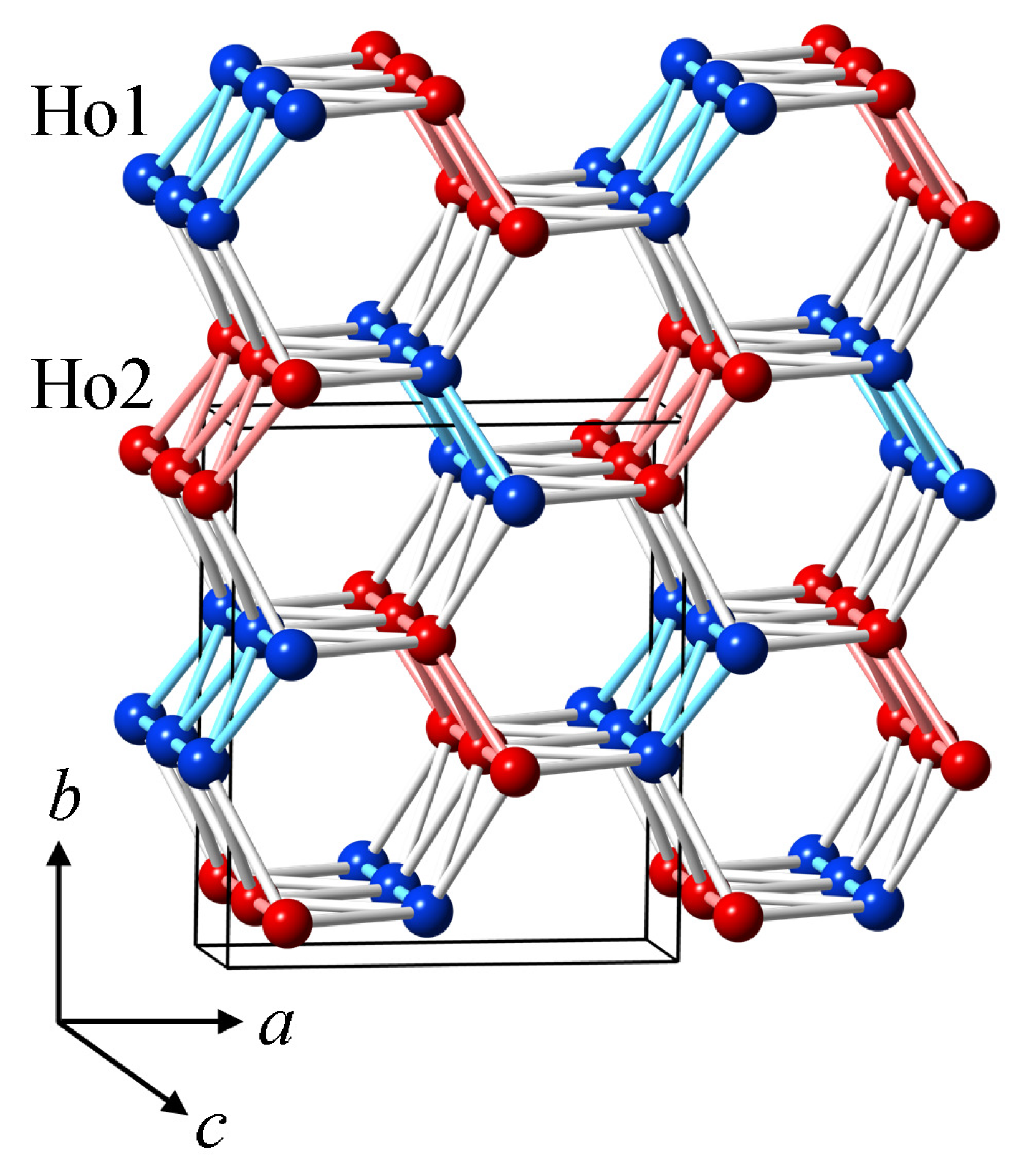

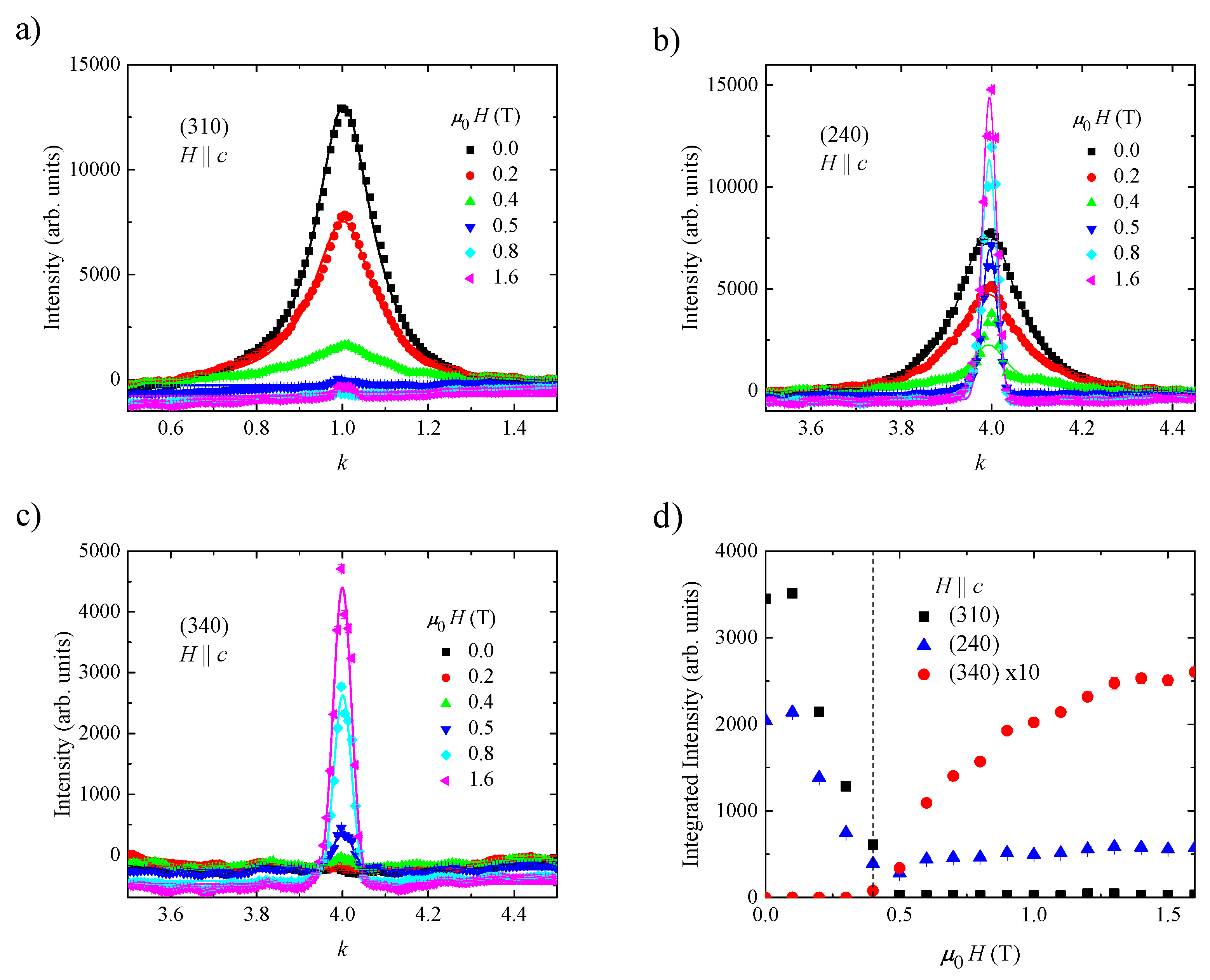
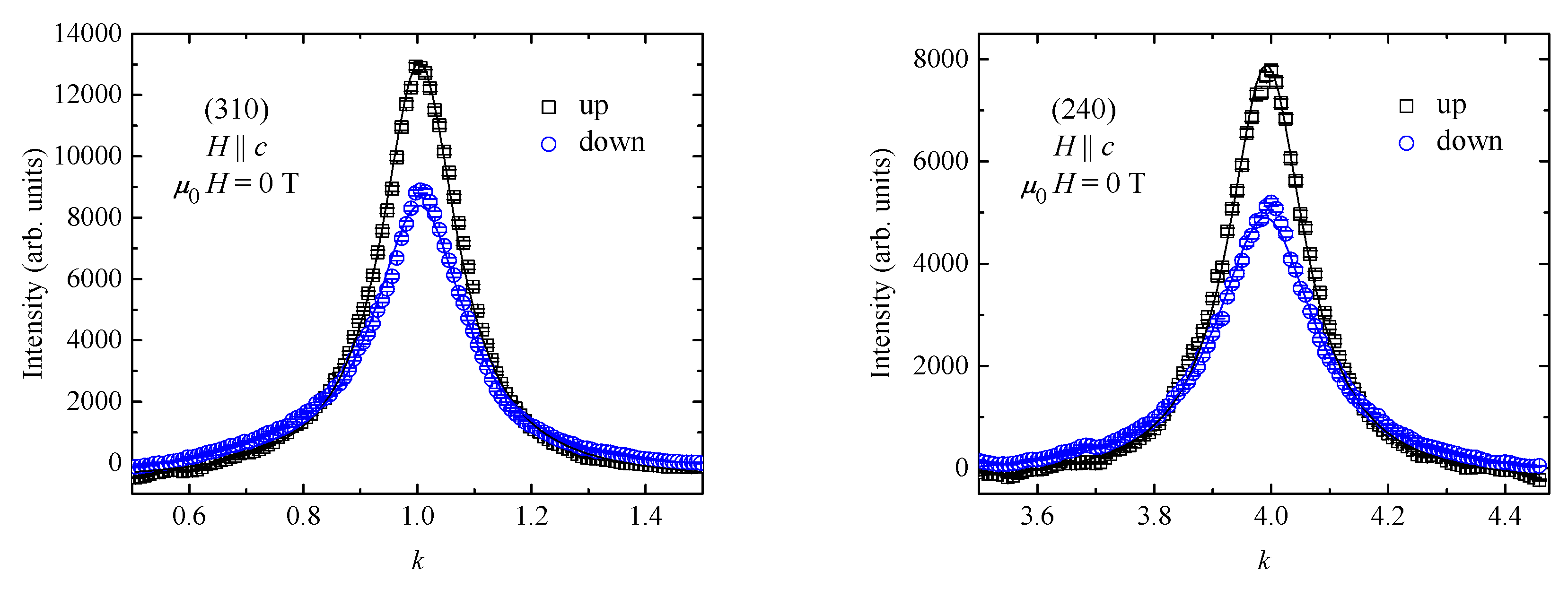
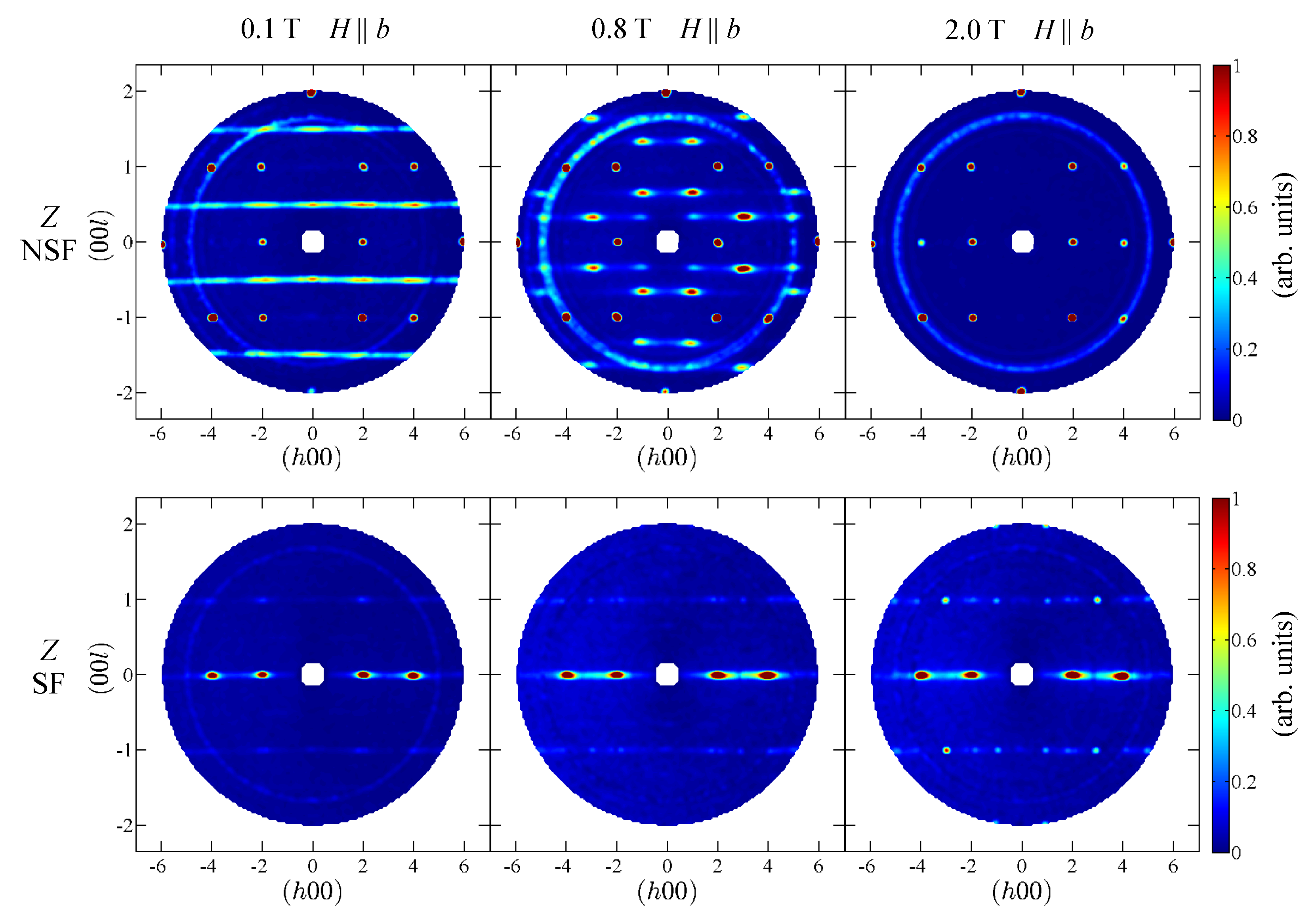
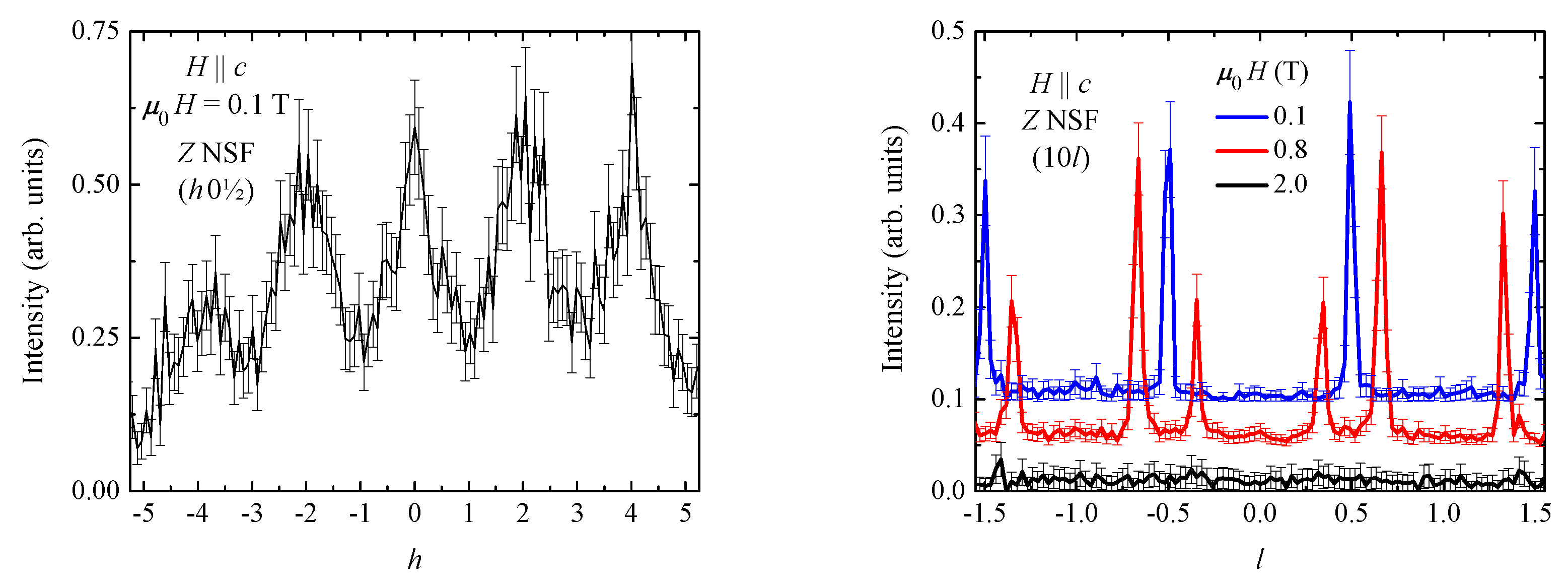
© 2019 by the authors. Licensee MDPI, Basel, Switzerland. This article is an open access article distributed under the terms and conditions of the Creative Commons Attribution (CC BY) license (http://creativecommons.org/licenses/by/4.0/).
Share and Cite
Young, O.; Balakrishnan, G.; Manuel, P.; Khalyavin, D.D.; Wildes, A.R.; Petrenko, O.A. Field-Induced Transitions in Highly Frustrated SrHo2O4. Crystals 2019, 9, 488. https://doi.org/10.3390/cryst9100488
Young O, Balakrishnan G, Manuel P, Khalyavin DD, Wildes AR, Petrenko OA. Field-Induced Transitions in Highly Frustrated SrHo2O4. Crystals. 2019; 9(10):488. https://doi.org/10.3390/cryst9100488
Chicago/Turabian StyleYoung, Olga, Geetha Balakrishnan, Pascal Manuel, Dmitry D. Khalyavin, Andrew R. Wildes, and Oleg A. Petrenko. 2019. "Field-Induced Transitions in Highly Frustrated SrHo2O4" Crystals 9, no. 10: 488. https://doi.org/10.3390/cryst9100488
APA StyleYoung, O., Balakrishnan, G., Manuel, P., Khalyavin, D. D., Wildes, A. R., & Petrenko, O. A. (2019). Field-Induced Transitions in Highly Frustrated SrHo2O4. Crystals, 9(10), 488. https://doi.org/10.3390/cryst9100488




